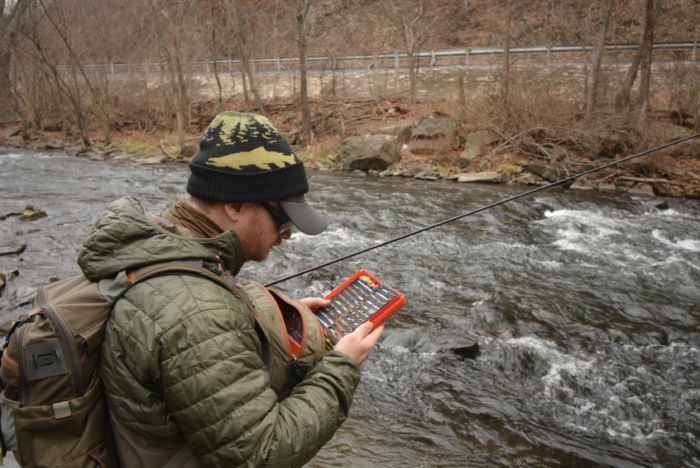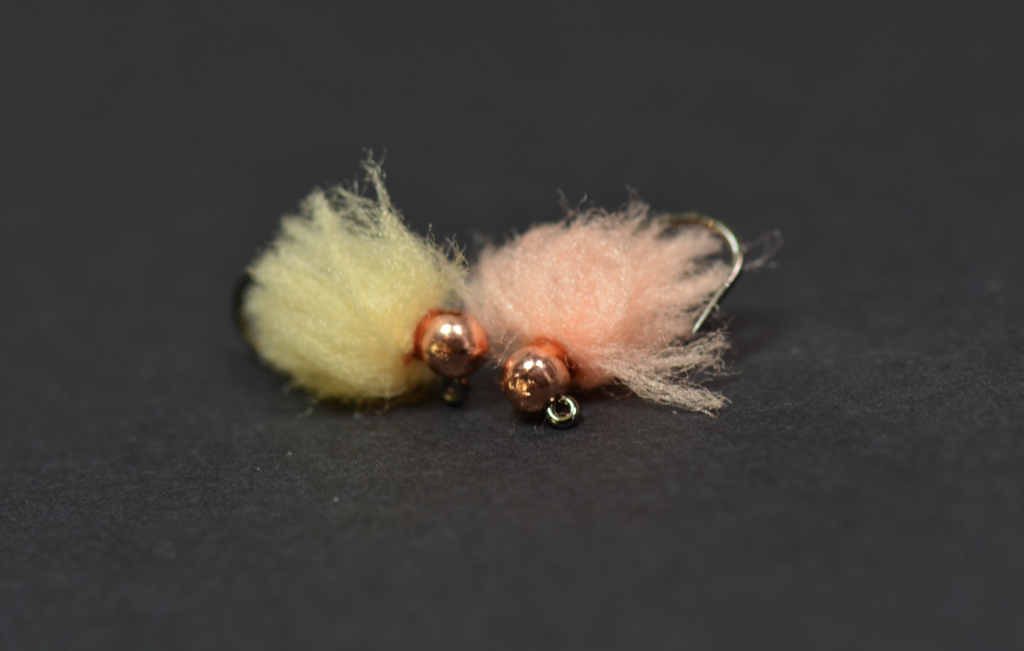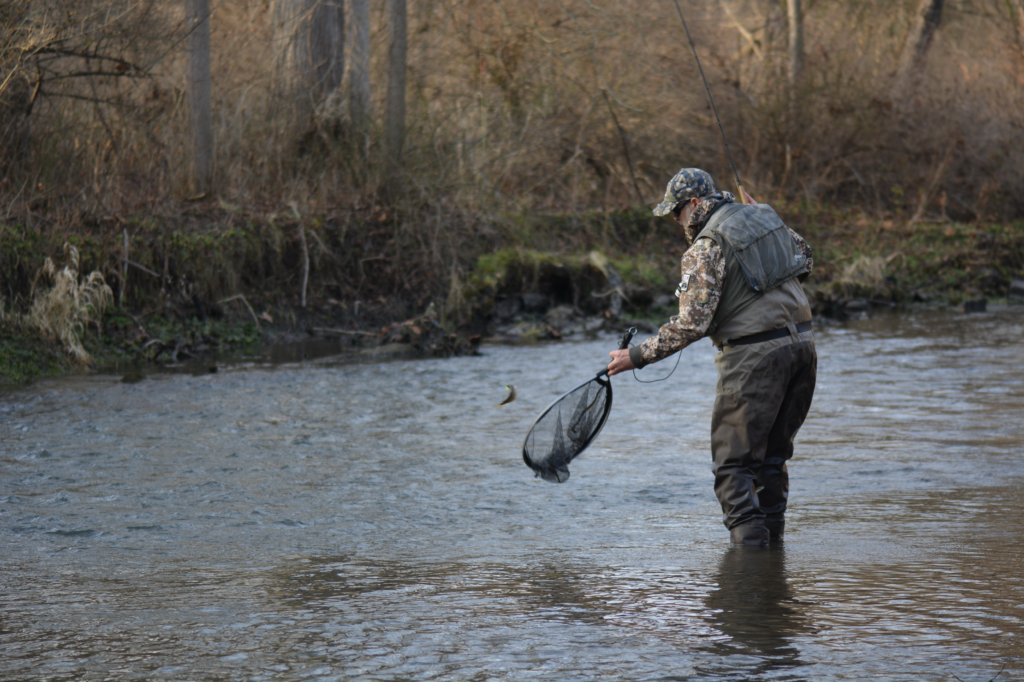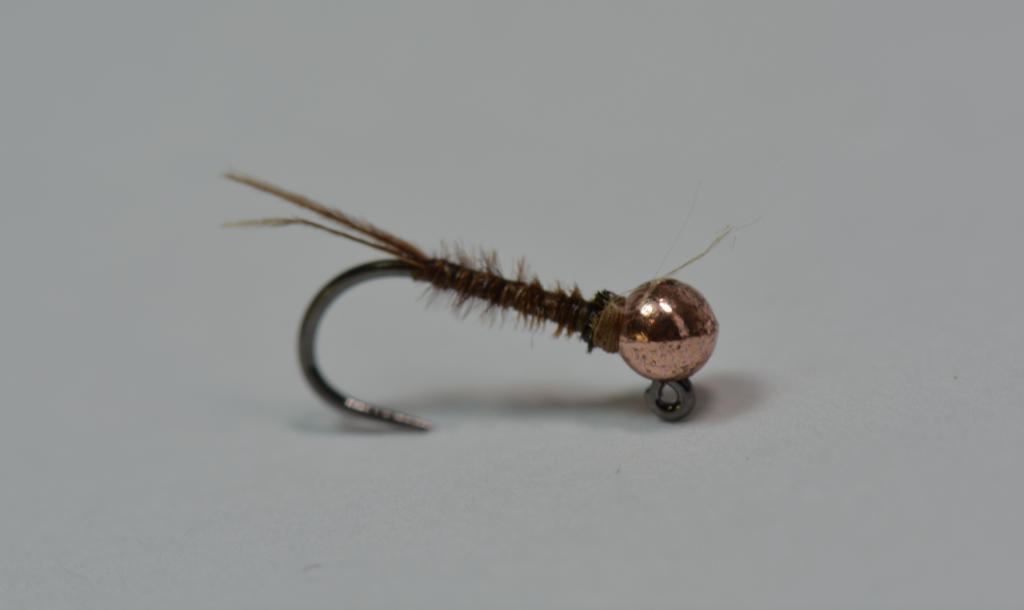
The Best Winter Flies and How to Fish Them
There’s a number of nuances that make winter fly fishing different from any other time of year. Most of these stem from just two main facts: the fish are cold, and food sources are both less abundant and smaller. Of course there are other factors at play, but in my mind these are the two most important considerations when I’m fishing in the colder months. How the fish react to these facts varies day to day, but it often requires us anglers to slow down, change our tactics, and use some winter flies.
If there was ever a day that could be made or broken fishing the right fly, it would be in winter. A trouts metabolism plummets when the water temperatures start creeping toward the thirties. They don’t want to move as much for food, especially if it doesn’t look particularly interesting. It’s still not as important as the right drift, but a good winter fly is important. I have four main flies I run through in winter before anything else: eggs, mops, pheasant tails, and jig streamers.
Eggstacy Eggs

It’s no secret, more often than not an egg is the best winter fly. When I get back to trout fishing in December, an egg is always the first thing I tie on. It’s not always the winning fly, but it usually is. Prime egg time is from December to February, but many years I’ll find myself throwing them into mid-March. In rivers with a good number of spring-spawning wild rainbows mixed in, the timeframe can be even wider. It may seem odd to throw eggs that long after the trout spawn is over, but I think they instinctually know eggs are food and just can’t pass up big easy protein in the winter. PA steelhead are a great example of this, they’ve likely never seen a real egg in their life but still eat egg flies with near reckless abandon. That being said, the higher the spawning trout population a river has, the better eggs tend to work.
The fly
Don’t get fancy with it! There’s no reason to overcomplicate an egg fly. Multi colored Glo Bugs and super realistic patterns like Nuke Eggs aren’t going to catch you more fish. The only egg fly I use is a simple Eggstacy pattern with a copper bead. Most often I use just three wraps of material on a size fourteen hook, but I sometimes trim them down for pickier fish. I tie them in a yellow-orange and a reddish-orange color. If they want eggs and one color isn’t working, the other is. After fishing these egg patterns exclusively for the past four years or so, I’m pretty confident that I couldn’t catch more fish on anything else.
How to rig and fish it
A real egg is neutrally buoyant, and bounces weightlessly all around the bottom of the river. I used to try and copy this as closely as possible by fishing an unweighted pattern with split shot or as the dropper above a heavy fly. This rigging made sense but didn’t really catch me more fish when I tested it back to back with a weighted fly. That’s not to say there’s no merit to a more natural movement in an egg fly, but you can get a pretty similar action with a weighted fly. That along with the fact that it’s easier to control and flip into tight spaces makes a weighted pattern my go to. Fishing an equally weighted or lighter dropper fly above the egg works well too, but it’s best to keep the egg on point.

More often than not eggs are best fished low and slow. I have the most consistent success crawling them along the bottom and tucking them into all the divots and potholes on the streambed. This doesn’t necessarily mean fishing a super heavy fly; a lighter fly (~3mm) fished on a slowed down drift is often the ticket. Just heavy enough to get down and hold its place but light enough to impart some more natural movement. If it seems like the fish are more lethargic, then I’ll go to a heavier fly and really crawl it along the bottom. When they’re eating like this the takes can be more slow and subtle, and you may need to let them “chew on it” for a second before setting the hook. The bottom isn’t always where you need to be though. I’ve had a number of winter outings where the egg gets inhaled well before it’s fully sunk. On days like this I’ll either use a three tiered approach or switch to a lighter fly to present them with a slower sink rate.
Mops

A second junk fly on the list may be a bit of a hard sell, but winter trout often need something gaudy to convince them to eat. A mop has a lot of what I call “pulling power”. It’s big and bright, and gives even the most lethargic trout a reason to move a bit out of their way. It’s not as consistent as an egg, but it can save a trip every now and then, especially during the coldest days of the year. I find it most useful for running cleanup by fishing it through a spot after my main flies for the day to pick up an extra fish or two. It works best on tailwaters or rivers with limestone influence, but always has at least some effectiveness.
The fly
Chartreuse is undoubtably the top color, but cream/tan can work every now and then. I tie them big- about an inch and a quarter long on a size ten jig hook. I want to show the fish a huge meal they can’t pass up. I really only tie them with 3.5mm or 4mm beads because of the way I fish them. Similarly to my egg patterns, I keep these simple. No dubbing collar or rubber legs, just a mop on a hook.
How to rig and fish it

I prefer to fish it as a single fly but will also put it on point below a small dropper. I will sometimes fish a three tiered approach if I’m getting strikes before the fly anchors on the bottom, but usually I just send it straight down. I fish it with a steeper sighter angler or a true downstream drift to get the slowest presentation possible. The benefit of a mop is that it sucks up water and has a lot of drag. This resistance helps it creep along the bottom extremely slowly, and the size and material prevent it from getting caught in crevices and cracks as easily as many other flies. During the drift it will occasionally come to rest on the streambed, which makes it an even easier meal to pick up and seems to trigger a strike. If it doesn’t I’ll give the fly a small jig to move it upwards into the current to restart the drift.
Pheasant tails
A fly that needs no introduction. A pheasant tail will catch a fish on any river any day of the year, however I find them on my rig more often in the colder months. It’s the first natural fly I’ll throw in the winter to gauge what the fish want for the day. I stick to a plain, drab pheasant tail as opposed to a brighter frenchie style pattern, at least to start. I find that a brighter “natural” fly is more hit or miss than the drab pattern any time, but especially when the trout are sluggish. When tied sparsely the trout could take it for a mayfly, midge, or anything else. I even use it in small sizes in place of some more standard winter patterns like zebra midges.
The Fly
My pheasant tails are extremely sparse. I use only three tail fibers for the body, counter wrapped with the tag end of the thread. I taper the body slightly by adding another layer of thread on the front half of the hook shank. Copper and silver beads are standards, in any size from two to four millimeters. I’ll often overbead these flies for when I feel I need a smaller fly in the heavier water that often comes with snowmelt. Something like a three millimeter bead on a size eighteen or a three and a half millimeter on size sixteen works well.

Conventional wisdom is to fish smaller nymphs in the winter, however I never like to downsize solely for the sake of downsizing. I have had plenty of winter days when a size fourteen fly outfished an eighteen despite there being relatively few larger nymphs available. Winter trout do tend to prefer smaller offerings, but make sure to have some larger bugs available. Overall, a size sixteen jigged version works well on most winter days.
How to rig and fish it
Fish tend to be picky about how their nymphs drift in the cold. Compared to the first two flies on the list a small pheasant tail doesn’t offer nearly as much of a meal, so it needs to be enticing. Like everything else in winter the trout usually like nymphs presented slowly, but finding the exact rigging and drift they want to see can take some time. I prefer starting with a single fly, as it’s easier to work in a number of different drift styles. Unless I have some reason to do otherwise, I start with medium weights and work deeper and slower until I find what the fish want. Sometimes it’s necessary to fish lighter tippet in order to sink lighter flies for a different presentation. When a single fly isn’t doing the trick, changing the rigging can make a difference. My favorite alternative is fishing a fairly light pheasant tail above something with a lot of drag, like one of the flies listed above. This gives the slowest drift possible, and can really work well when the water is at its coldest.
Jig streamers

Another big meal a cold trout can’t pass up. A fast, erratically moving streamer may be a hard sell to a lethargic fish, but when fished slowly and in their face, it looks like easy protein. I find myself throwing a jig streamer on when I’m not having much success on junk or naturals. They get overlooked a lot, but they can certainly put big numbers in the net on the right day. As a bonus, they tend to attract a slightly higher average size fish than most nymphs.
The fly
Sticking with the trend, my jig streamers are simple. Just a marabou tail with a laser dub or polar chenille body, depending on if I want it flashy or not. You get the best motion by stripping the marabou fibers from the quill and tying them in instead of using the whole feather. A bunch of fibers around three millimeters in diameter creates a good profile. Rabbit strips also work well, but they’re better for more dead drifting specific flies. Either way I like a size ten jig hook for general fishing or larger if I’m looking for bigger fish.
Weight is key with jig streamers. The heavier it is the easier it is to control and manipulate in the water. I use a minimum of a four millimeter bead for jigging flies, sometimes much heavier. Lighter flies come in handy for dead drifting, but they’re not as versatile. My best colors are olive and black, especially when the water is colored up.
How to rig and fish it
When I plan to actively fish a jig streamer it’s always rigged as a single fly, and always on a slightly heavier tippet than I use for nymphs. When fishing jig streamers in the cold, slow movements work best. As the temperature drops the river’s baitfish experience a metabolism drop just like its trout. They become slow and immobilized, and have a hard time maintaining their position in the river. I always try to mimic this vulnerable behavior with my presentation.
Once the streamer hits the bottom, use slow lifts and drops to bring it back while bringing line in on each drop. Keeping contact and control is difficult, but important for feeling the sometimes subtle strikes from lethargic trout. The magnitude of the up and down movement can be anything from a few inches to a few feet depending on the day. Water depth and speed plays a role, but I normally base fly weight off of fishing speed. The faster you want to move the fly the more weight you need to maintain control. Four millimeter beads work well for most winter fishing, but it’s good to have some extra heavy patterns for when the fish want a chase.

Active presentations don’t always work. I like to switch between active and dead drifts throughout the day until I find which wins out. I keep it moving slowly either right on or just above the bottom. Sometimes I’ll give it a slight jig or very small movements to make it appear to have a bit of life left, but really it’s just like fishing a larger nymph or junk fly. Mentally it can be difficult to fish a streamer without moving it around, but it can be surprisingly effective.
Final Thoughts
This certainly isn’t every winter fly I fish, but they are my go-to’s. Something on this list usually works pretty well on any given winter day here in the northeast. You may be able to tell that the big trend in my fly selection for cold weather is patterns that catch attention and offer a big reward. I have the most confidence fishing flies that give the fish a reason to move when they really don’t want to.
Of course, these flies aren’t always the best move. The trout often want a more natural offering, and when they do I like to give them something plain and generally attractive. The easier it is to distinguish as food the better. I’ll cycle through a few nymph patterns outside of just a pheasant tail if need be: Walt’s worms, Frenchies, tag nymphs, France flies, and other simple, general flies. I fish them all in the same way though, so including them here felt a bit redundant.
There’s plenty of popular winter flies I left out as well. Some, like midge specific patterns, I don’t feel offer enough advantage over my regular nymphs to carry. Others, like larger stoneflies, aren’t prevalent in my local rivers. I don’t fish them as often because it’s just not something my fish see much of. Depending on where you fish and what you like your top winter flies may be a bit different. That being said, I can say with a good bit of confidence these four flies won’t let you down very often.
If this article helped you out, stay tuned for the next winter fishing installment: Staying warm on the water.
Catch some fish and don’t freeze out there,
-Mike Komara
